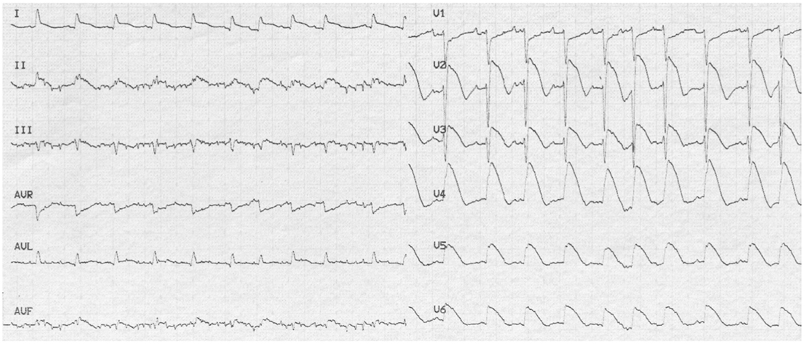Korean Circ J.
2011 Nov;41(11):692-693. 10.4070/kcj.2011.41.11.692.
Electrocardiographic Changes in a Patient With Pulmonary Embolism and Septic Shock
- Affiliations
-
- 1Department of Cardiology, Asklepeion General Hospital, Athens, Greece. antonispav@yahoo.com
- 2Emory University School of Medicine, Atlanta, USA.
- KMID: 2225082
- DOI: http://doi.org/10.4070/kcj.2011.41.11.692
Abstract
- Various electrocardiography (ECG) abnormalities have been reported in patients who present with pulmonary embolism (PE). Severe sepsis is also associated with ECG changes that may mimic ST elevation myocardial infarction. We report a case of an elderly patient with PE and septic shock associated with striking ECG changes.
Keyword
MeSH Terms
Figure
Reference
-
1. Ryu HM, Lee JH, Kwon YS, et al. Electrocardiography patterns and the role of the electrocardiography score for risk stratification in acute pulmonary embolism. Korean Circ J. 2010. 40:499–506.2. Goslar T, Podbregar M. Acute ECG ST-segment elevation mimicking myocardial infarction in a patient with pulmonary embolism. Cardiovasc Ultrasound. 2010. 8:50.3. Lin JF, Li YC, Yang PL. A case of massive pulmonary embolism with ST elevation in leads V1-4. Circ J. 2009. 73:1157–1159.4. Martinez JD, Babu RV, Sharma G. Escherichia coli septic shock masquerading as ST-segment elevation myocardial infarction. Postgrad Med. 2009. 121:102–105.5. Terradellas JB, Bellot JF, Sarís AB, Gil CL, Torrallardona AT, Garriga JR. Acute and transient ST segment elevation during bacterial shock in seven patients without apparent heart disease. Chest. 1982. 81:444–448.
- Full Text Links
- Actions
-
Cited
- CITED
-
- Close
- Share
- Similar articles
-
- Pulmonary Valve Endocarditis with Septic Pulmonary Thromboembolism in a Patient with Ventricular Septal Defect
- Dyspnea Due to Candidal Septic Pulmonary Embolism Originated from Odontogenic Infection
- Klebsiella pneumoniae-induced Liver Abscess Complicated with Septic Pulmonary Embolism in a Non-diabetic Adult
- Intraoperative diagnosis of right atrial thrombi with pulmonary embolism using transthoracic echocardiography
- A Case of Emphysematous Pyelonephritis Complicated with Septic Pulmonary Embolism



